| YAYAMAMA This is one of the best known and most famous sculptures of Taraco. It was extensively described and studied by Sergio Chávez and Karen Mohr during the 1970’s. It is a great, quadrangular pillar of gray quartzite, with polished surfaces and round edges. The four faces have been engraved with figures in bas-relief. Representations of a man and a woman with crossed arms over the chest occupy parallel faces, in symmetrical opposition, so that their gazes are oriented in opposing directions. Their faces, with round eyes, eyebrows and nose joined into the shape of a T, an ajar mouth in the form of an oval , and thick lips accompanied by lines that resemble a moustache and beard, are typical representations during the Formative period. The other two faces of the monolith have figures of two-headed snakes but with long ears that seem to represent another animal. Another important element of the design is heads with human faces out of which appendices project that resemble hooks. The iconography has shared similarities with the monoliths of Pucara and Tiwanaku, but also shares similarities of design with the Paracas culture of Ica. Chronology: Middle Formative (1300 – 500 B.C.)Origin: City of Taraco |
 |
MONOLITH OF THE SNAKE MONOLITH OF THE RAY On both faces of a great, long block of stone shale has been engraved by incision the figure of a Ray. This image is highly symbolic since it represents one of the greater expressions of the power of nature. A supreme power that was personified in the Tunupa or Illapa deity responsible for fertilizing much of the land (Pachamama) as the lake (Kotamama) would be represented in the upper part of one of its faces. Chronology: Middle Formative (1300 – 500 B.C.) Origin: Unknown |
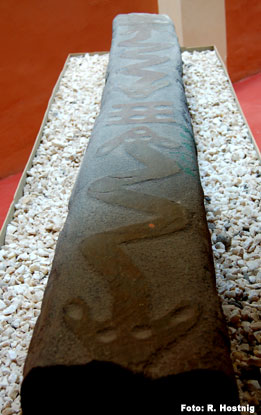 |
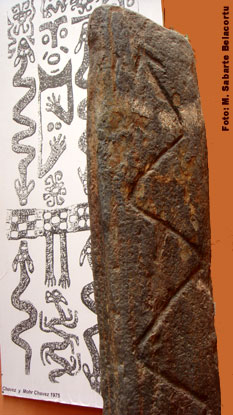 |
ENGRAVED STELAE FLAT STELAE These are flat blocks of stone, rectangular in form with well defined faces. They were produced from relatively smooth materials such as sandstone and shale. Generally the surfaces are flat without engravings, but in some cases geometric designs are evident on one or more faces. This type of monolith was heavily used to construct the faces of the sunken temples of Pukara. Chronology: Late Formative (500 B.C. – 400 A.D.) Origin: Unknown |
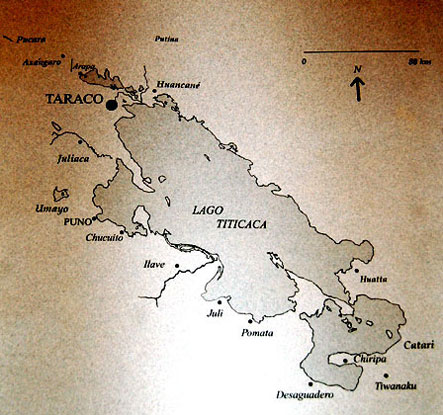 |
|
SEQUENCE OF THE PREHISPANIC HISTORY OF THE ALTIPLANOIn the prehispanic history of the Andes, the altiplano represents one of the principal centers of high culture. It not only was one of the richest and most densely populated regions but also constitutes a center of origin in the domestication of plants and animals, the appearance of the first village groups, copper metallurgy, and the development of the state. The prehispanic historical and cultural process of this region has been divided into five wide periods that cover more than 10,000 years of history. These periods are clearly identified along the Ramis river, in a diversity of sites that offer a great body of information for understanding the prehistory of the region.
Stone sculpture is one of the most complex and valuable cultural traditions to have developed in altiplano societies. It constitutes a high expression of both universal and Andean art. A deeply symbolic, conceptual and ritual art, it synthesizes and expresses the world view of the people who created it. The iconography includes images of animals, both real and mythical, divine and sacred gods, and geometric figures of allegoric character. Nevertheless the fundamental intention was not to create an exact and faithful image of reality, but rather was to grasp and express the essence of the represented person, animal, or object. But this stone sculpture was not a purely aesthetic art. It was a functional art that condensed cosmological, religious, and technological meanings, as well as political and ideological conceptions. It was an official art, one suitable for a very developed and complex society. Its elaboration and ritual use was carried out by groups of specialists narrowly linked to and dependent upon the elite rulers who adopted the art as a mechanism for the creation of elements of ethnic identity as well as symbols of their political and religious power. The prehispanic sculptural tradition in the Lake Titicaca basin is basically related to the Formative period (1300 B.C. – 400 A.D.) and Tiwanaku (400 – 1100 A.D.). In this time, nearly 2500 years, the sculptural styles changed and evolved. The oldest sculptures would also be the simplest, stone blocks of irregular contours but with slightly rectangular or pyramidal forms, of the huanca type, whose surfaces were only planed to eliminate irregularities and were without any type of design. Subsequently large monoliths with worked surfaces in high and bas-relief were incorporated, with symbolic and naturalistic representations of animals, divinities, and geometric figures. Finally there were three-dimensional monolithic figures, of priests or gods adorned with a complex symbolic iconography. Stone sculpture did not serve only monumental and ritual purposes; sculptures with a structural and ornamental character in architectural constructions were also used.
In the context of prehispanic history, Taraco represents an important center in the development of Andean sculptural art. It was during the Formative period that stone sculpture reached its greatest development and meaning. |
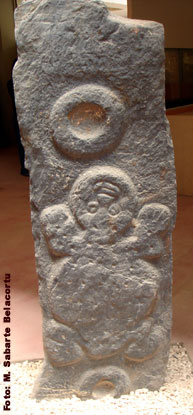 |
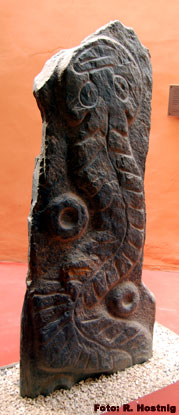 |
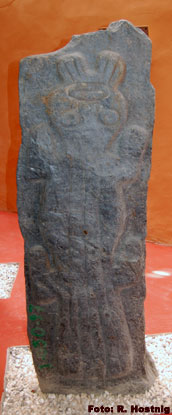 |